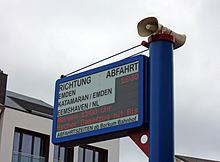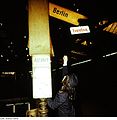Train destination indicator

Train destination indicators are display boards that display information about the destination of arriving or departing trains and the like. Passengers can use it to keep themselves up to date when the displays are updated. They can be found at passenger stations with transfer options as well as (then referred to as destination displays ) at stops of S-Bahn trains , buses and the like. In addition, they can also be attached to the means of transport mentioned . Depending on the design, they can consist of both a variable and a constant area.
The forerunner of modern display boards on vehicles is the train route sign . Such signs were originally made of sheet metal and were attached to the outside of the railroad cars. Comparable, but significantly smaller, signs were placed in the entry areas. They were used in particular to make through car groups recognizable for travelers passing through the train. Often one direction of travel was printed on the front and the opposite direction on the back, the boards could then simply be turned around for the return journey. Plastic signs later came into use, and due to the increasing speed of travel, concealable recesses were made in the side walls for the train route signs. As a replacement for both shapes, those of the small shape were attached to the inside of the entrance door windows in the 1990s. However, these are rarely used any more, as they are being replaced by electronic displays on and in the passenger coaches.
Train destination displays at stations and stops
At train stations, they are usually attached to the track access points (e.g. exits from underpasses etc.) or distributed over the entire length of the platforms . You can display the following information:
- Name of the track ( e.g. track 10a or track 9 north )
- Arrival or departure time
- Train types ( ICE , IC , IRE , RE , RB , S etc.)
- Train number or line number
- Destination (terminus) of the train
- (selected) intermediate stops
- Car level indicator (especially for long-distance trains)
- possibly delay times,
- If necessary, other information: such as quality deviations (changed train compositions, missing dining car, missing reservations ...), information about train cancellations.
Since 2015, Deutsche Bahn has been using a multi-train layout with details of subsequent trains, although the name of the track can be omitted.
Designs
Mechanical train destination indicators
Mechanical train destination indicators have been in use since the 19th century. These were fold-out rectangular boards with destination information attached to a mast. The panels, which cannot be seen in the basic position, were folded out into the readable position with a pull rod for display purposes. Because of this mechanism, these devices were commonly referred to as jumping jacks . At larger stations, the train destination displays were designed so that several boards could be unfolded at the same time, with which, for example, the type of train could be displayed in addition to the destination . In many cases, the mechanical train destination displays have now been replaced by more modern and remote display boards .
Railway woman adds the addition " Express train " in Dresden Central Station (approx. 1975)
Panes of glass with fluorescent tubes
Train destination displays of the Deutsche Reichsbahn often consisted of small and medium-sized stations made of glass panels printed on the front or back, in which fluorescent lamps lit up behind the respective pane to signal the destination of a train. Despite the simple, inexpensive construction, the disadvantages predominate: If the fluorescent lamp failed, the information failed and if the timetable was changed, the relevant boards had to be replaced. Nevertheless, this type of train destination indicator is still used in some cases. This technology was also used in local transport outside the GDR, for example on the Berlin and Hamburg subways . In September 2012, such indicators were still in operation on the northern part of the S1 line - from Wilhelmsruh northwards - on the Berlin S-Bahn because the changeover was planned but not yet carried out.
GDR variant with fluorescent tubes in Leinefelde ; changes can be recognized by the many different fonts
Display board of the West Berlin U-Bahn line 4 in the Berlin U-Bahn Museum
Scroll indicator
Until recently, scroll indicators were widely used. In addition to individual strips for the departure time, all data of a train run were displayed on one position of the conveyor belt. This required the replacement of the entire conveyor belt or the covering of the corresponding belt position for new train runs. For this reason, this form of display was replaced early on by drop-leaf displays at larger train stations. The good legibility and the energy requirement only when changing are advantageous.
Roll tape indicator in the station Sarreguemines , France
Fall leaf indicator
Fall leaf indicators consist of rotating printed cards to display information. The display is limited to defined terms, letters and numbers . The number and arrangement of the information displayed depend on the number and arrangement of the individual case sheet registers. In addition to this low flexibility and high mechanical wear, they offer optimal readability. Sometimes, however, the cards jam, the information becomes illegible or wrong destinations are displayed. These are often captured photographically.
Germany: Frankfurt (Main) Hbf (Deutsche Bahn, type AEG, until September 2005)
Austria : Wien Handelskai (formerly)
Switzerland : Lausanne (formerly)
LED / LC screens
The latest variant of the train destination display is digital and uses light-emitting diodes (LED) or liquid crystal screens (LCD). The so-called full matrix displays have the advantages that they are less susceptible to interference, information can be displayed more legibly on self-illuminating screens and screens are not restricted to a fixed set of characters such as fall-leaf displays . An update of the software brings all digital displays up to date and thus saves thousands of tabs from having to replace old analog displays, which would be necessary, for example, after changes in train routes, in the operation of the station or after the opening of a new station. Faults can also be announced simply and in detail.
This variant is also characterized by the possibility of highlighting (through enlargement, bold text and other formatting) and space saving through ticker text or scrolling .
At Deutsche Bahn , these displays consist of several dark blue screens that are illuminated from behind by fluorescent tubes or LEDs on current devices. The displays are monochrome (dark blue and white) and have a comparatively low resolution. This means that they cannot display colored car stands , but they achieve a high level of contrast and, thanks to the transflector film used between the backlighting and the LCD glass, can be read even in direct sunlight.
Design change of the DB
As a result of the change in the design of the Deutsche Bahn, clocks , station signs and other boards were also adapted, as well as the train destination displays. In the past, the information was presented with black text on a white background ( positive ) and today with white text on a dark blue background ( negative ).
Deletion of the displays at train stations
The display is mostly deleted after the train leaves the station, either
-
automatically ,
- through data pulses generated while driving,
- by holding sensors or camera technology,
- time-controlled by "processing" the station timetable
- or triggered manually by the operator of the passenger information system or by the train attendants . In Germany, the latter is initiated with a square key on a control column, which is identified by a sign with a green mushroom in a ring. There is also the switch for the departure announcement, which comes from the tape as standard at Deutsche Bahn or is reproduced by a computer. At another counter, the electronic departure signal ("Zp 9") is given with a little delay before the train driver gets on.
Train destination indicator on means of transport
This is the oldest form of target scoreboard. Train route signs made of sheet metal used to be attached to the front sides of steam locomotives, especially in local transport around large cities (for example on the Berlin “Stadt-, Ring- und Vorortbahnen”).
Outside of means of transport (locomotives, passenger coaches, railcars and the like), the train destination indicators are usually in the front, but also on the sides of the vehicles. In classic travel, the train route signs were hung on the side walls of the passenger coaches. There are standardized recordings for this. In addition, smaller signs with the same content were placed in the entry areas, which were mainly legible from the interchange. These inside signs were especially important when moving through cars . From around the beginning of the 1970s, the German railways used train route signs without directional information (for example, "Leipzig - Dresden - Leipzig") for train units that traveled a route several times a day in both directions.
LED displays are predominantly used today in newer vehicles . The displays with bistable display elements that have been customary since the 1990s and the LCD displays that have been customary since the 2000s are also frequently encountered . Similar to local and urban transport vehicles, locomotives for passenger transport are also increasingly being equipped with train destination displays on the end faces. These indicators mention on average (only):
- Line designation
- Travel destination (or end station)
- if applicable, train type as an abbreviation
- possibly next station
- If necessary, brief instructions ( "Do not board" , "Train ends here" , etc.)
LED destination display of a French TGV
Destination displays of bistable display elements at a German commuter train
Train direction sign of the Wupper-Express
Train direction sign of the Eurocity Iris from Brussel-Zuid / Bruxelles-Midi to Zurich HB
Double hyphen in the station name to distinguish it from the line dash






































